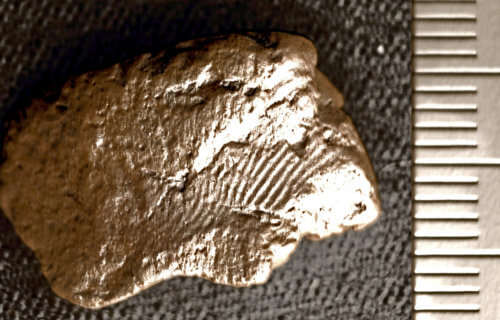WINNIPEG, Manitoba — Analysis of fingerprints found on a piece of Neolithic clay reveals they belonged to two young male potters from 5,000 years ago. The imprint was found on a shred of pot recovered from the Ness of Brodgar excavation site in Orkney, an archipelago in Scotland that’s home to the “Heart of Neolithic Orkney World Heritage Site.”
It was first discovered by a ceramics specialist in April 2021 who was examining shreds of clay from the area, the largest collection of late Neolithic grooved ware pottery in the United Kingdom. Further analysis of a digital model created by specialists revealed another two prints which were examined by Professor Kent Fowler, director of the University of Manitoba’s Ceramic Technology Laboratory in Winnipeg, Canada. Only two were sufficiently detailed to analyze, however, the results revealed two different Neolithic males left their mark on the wet clay vessel.
Fingerprint components are known to differ according to age and sex. Experts measured the density and breadth of the fingerprint ridges, taking into account the shrinkage of the clay during drying and firing. Professor Fowler determined one was left by an adolescent or adult male between 13 and 20 years old, while the second print belonged to an adult male between 15 and 22.
“Although the prints exhibit identical average ages, there is little overlap in the ridge values between the two measured prints, suggesting one print was made by an adolescent male and the other by an adult male. Ethnographic and experimental accounts of hand-building techniques indicate that hands are normally only placed within closed-form vessels when fashioning roughouts and while manipulating the object to modify the exterior; wiping, smoothing, burnishing, etc.,” Fowler explains in a statement, per South West News Service. “External prints can accrue during shaping or when handling the vessel after the roughout is completed, but when the clay is still leather hard and will accept prints. In this instance, it is most likely that there were two printmakers and the interior print was left by the potter. At this stage we cannot determine whether the older or younger potter was responsible for shaping operations.”
Adds Nick Card, director of the Ness of Brodgar excavation: “With well over 80,000 pottery sherds found at the Ness of Brodgar, it can be all too easy to lose sight of the people behind them. This single sherd has brought two back into the spotlight and given us an unparalleled glimpse into life at the Ness complex 5,000 years ago.
“It also raises many questions,” he continues. “The creation of this pot involved an adolescent boy – did he fashion the vessel or was he just involved in the manufacturing process, perhaps overseen by a more experienced potter? Were all children engaged in the creation of pottery from an early age or was it a task that involved a select few. Also, were different types of vessels created by different people within the household or community? The analysis has much wider implications in the study of Neolithic ceramics, but we will need many more fingerprint examples before any firm conclusions can be drawn.”
SWNS writer Ellie Forbes contributed to this report.

It is “shards”. You called them sherds…?